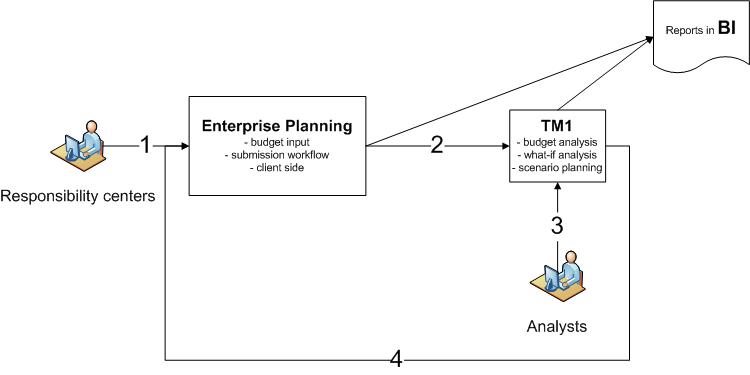TM1 + Enterprise Planning, When, Why and How?
This post will be some extracts from a recent PoC, where we made a complex planning system including a rich scenario modeling part. So it was our first big TM1 + EP integration experience.
Some basic definitions:
Cognos Enterprise Planning (aka Adaytum EP) is a very scalable system, all computing is client-side, nice workflow organization, nice GUI (version 8.4 Eclipse one especially) with huge limitations when it comes to the moment of “show me the whole budget in one place” or to serious what-if modeling. But scaling is trivial, each server acts as many clients simultaneously (number of cores\CPUs) and adding more servers scales the system linearly. So to build really scalable systems, we made Contributor only working places, with all analysis done in Cognos 8 BI and Analyst was turned into a modeling tool. In adaytum and cognos 7 times a lot of things(consolidating, what-if) could be done (and to be honest, still can be) in Analyst, but just up the point you reached 40mln cells cube limit in Analyst, then you started dividing cubes and the system became nightmare. Transforming the same consolidation task into series of Contributor applications connected by admin links gave huge performance enhancements, but the “show me the whole budget” limitation was a major problem.
Cognos TM1 (aka Applix TM1) is an in-memory OLAP engine, ultra-speed calculations, server side computing, excel based gui (with web publication), limited workflow capabilities (compared with current EP), scalability limitations (imagine putting servers across whole Russia to ensure response time)
So when it comes to a planning system with large user base – it’s EP, but if some serious modeling and calculations are requied as well – it’s time to fire up TM1 as well.
Overall interaction scheme seems pretty simple:

- Most of users work in EP inputting budgets, submitting and doing all other workflow related activities
- After some user actions (saving budget, submitting, accepting it) data is transferred into TM1.
- Detecting the desired action is easy – we’ve got Event Studio for that
- Incremental publish is fired and changed elist is republished – that’s pretty fast
- Then there’s a problem to extract only changed data from publication. That’s the same as with incremental admin links, you just write a simple database procedure that logs last data transfer time and create views showing only recent data (as usual, you want code samples – drop a line)
- Changed data is bcp’ed\sqlloaded to TM1 server
- TM1 TurboIntegrator process is fired, loading the extracted data into TM1
- Analysts work with “live” data in TM1, doing what-if analysis (they dynamically add scenario versions for this purpose), having access to all enterprise budget and actual data.
- Then a version could be used for top-down propagation and exported into EP (that’s pretty simple, just some writing into EP applications import tables)
The whole system seems pretty healthy, data transfers happens with 1-2 minutes latency (we used Save as trigger action). Doing any kind what-if analysis on a budget version only 2 minutes “stale” with ultra-speed seems very impressive to me. For instance, in that particular PoC the goal was to speed up overall company budget consolidation, including complex allocation and elimination rules. It took over 8 hours in their current system. And only 4 minutes in Tm1 – imagine all the benefits you can get from that kind of speed.
Since there are more and more rumours about coming TM1+EP bundle, I just hope that step 2 will be more automated. For example, they can track delta xml’s sent by contributor client, containing all data updates, instead of publishing and bcping. But I can see no way they can get rid of neccesity of creating 2 models, one in Analyst for Contributor applications and another in TM1. Although dlists\dimensions can be synchronized, calculations are utterly different (you can target specific cube cell in TM1 formula and only the cube slice in EP).